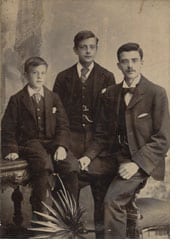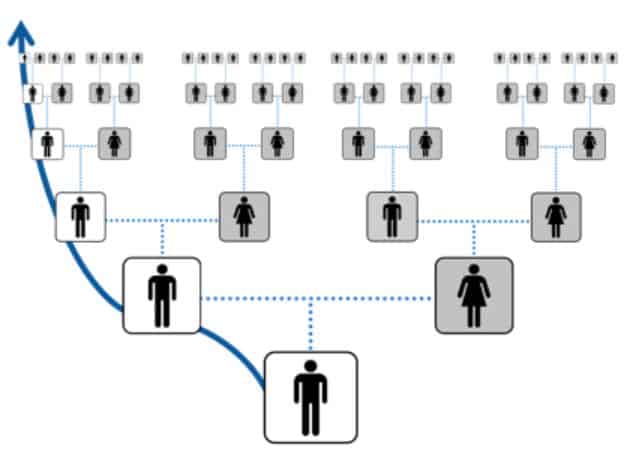
Y-chromosome testing can identify or confirm men in your paternal line. That’s because the Y chromosome passes from father to son with only an occasional mutation.
Since surnames usually don’t change along paternal lines, a man’s closest matches in a Y-DNA database will often share his surname.
That characteristic of a Y-DNA test will provide male adoptees with the surname of their biological father about half the time.
Matches on a Y-DNA test will be labelled with a Genetic Distance number. The smaller the number (zero is best) the more likely that your common ancestor lived within a genealogical timeframe.
Where Should You Do Y-Chromosome Testing?
Family Tree DNA (FTDNA) is the obvious choice for Y-chromosome testing. They offer several Y-DNA testing options and have thousands of surname projects that you can join for free.
Since this company offers all the test types, they will attempt to save the DNA from your first test for up to 25 years. When you order additional tests, you won’t have to provide a new sample.
NOTE: A transfer of autosomal data from another test only gets you into Family Finder. They need an actual DNA sample to do Y-DNA or mitochondrial DNA testing.
Who Should You Test?
Only men have the Y chromosome necessary for this test. Yet females can often participate in Y-chromosome testing by sampling a living male in their paternal line. This could be a father, a brother, a father’s brother, or a son of a father’s brother.
This test will also determine your Y‑DNA haplogroup, which identifies the ancient origins of your direct paternal line.
Note that haplogroups determined from direct Y-DNA testing can be more precise than those included with some of the autosomal DNA tests. And certain haplogroups will confirm Native American ancestry in your direct paternal line.

How Many Markers to Order?
Family Tree DNA will test 37 or 111 markers. While 111 markers provide more resolution among matches and more confidence in the timeframe of the common ancestor, you can start with 37 markers and upgrade to 111 later without submitting a new sample.
That start-small-and-upgrade strategy will cost more in total. Yet a small fraction of men will see very few matches at 37 markers and an upgrade to 111 is unlikely to help much in that case.
The choice is yours.
Y-DNA SNP Testing
The traditional Y-DNA testing mentioned above looks at markers called STRs. Using a tree analogy to represent the paternal lineage of all human males, Y-STRs help you identify your family’s leaf.
Y-SNPs, on the other hand, define branches on the male tree. The larger branches split thousands of years ago and have continued to split into smaller branches. We describe all this branching with haplogroups and subclades.
While SNPs have been always tied to our ancient ancestry, they have not been relevant to genealogy. But that is changing.
New tests such as Family Tree DNA’s “Big Y-700” test, are now uncovering thousands of previously unknown SNPs. Many of these define more recent branches and some testers are now able to distinguish among different families with the same surname.
NOTE: The test is called Big Y-700 because you will get 700 STR markers in addition to testing tens of thousands of SNPs.
If you want to learn all you can from Y-chromosome testing, order Big Y-700 now. If you have already done STR testing, log into your account at Family Tree DNA and upgrade to the Big Y test. The price will be reduced based on how many markers you have already purchased.
